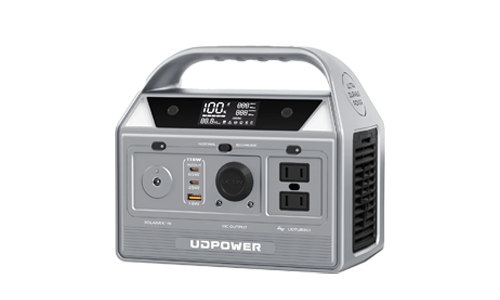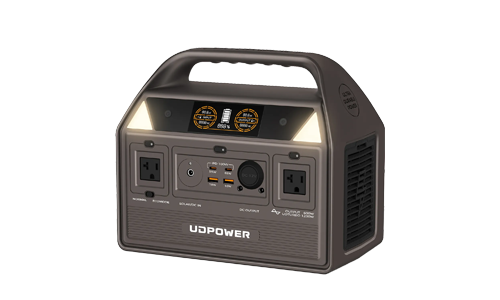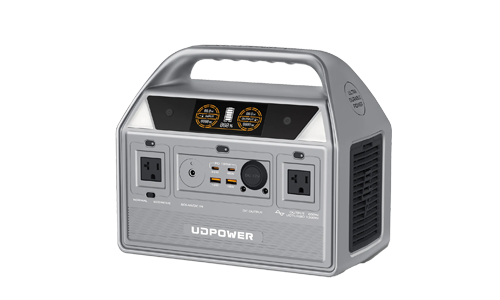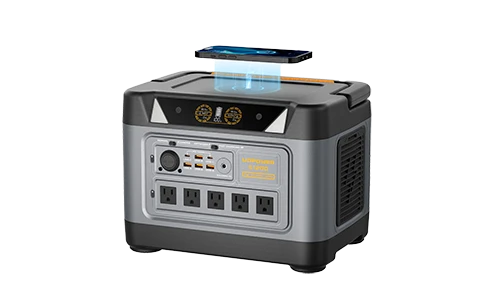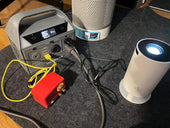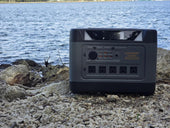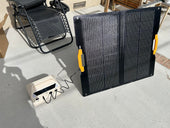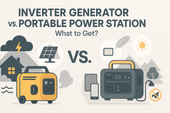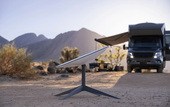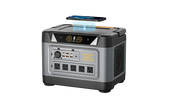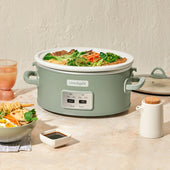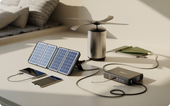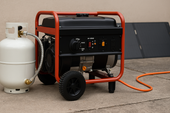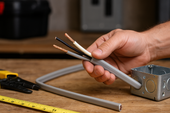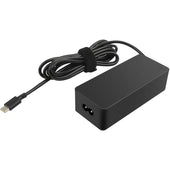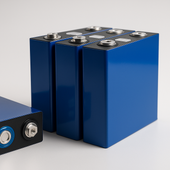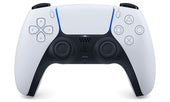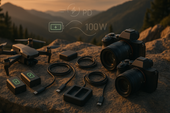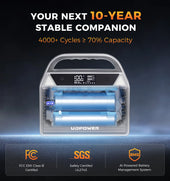All Types of Chargers Explained (and How to Pick the Right One)
ZacharyWilliamCharging 101
Wall bricks, USB-C, wireless pads, car adapters, power banks, and even portable power stations — modern life runs on chargers. This guide walks through every common charger type, what it’s best for, and how to choose the safest option for your phones, laptops, and off-grid setups.
Charging Basics: Volts, Amps, Watts & Connectors
Before comparing charger types, it helps to understand the basic language on the label. Most consumer chargers are USB-based now, but the same rules apply whether you’re plugging into a wall brick or a portable power station.
- Voltage (V) – The “pressure” that pushes electricity. Most phone and laptop chargers output 5–20 V.
- Current (A or mA) – How much electrical “flow” is available. Higher amps allow more power at the same voltage.
-
Power (W) – The total charging capability. It’s
Watts = Volts × Amps. A 20 V × 3 A USB-C charger delivers up to 60 W. - Connector vs. protocol – USB-C is only the plug shape. Power Delivery (PD), PPS, and quick-charge systems are the protocols that negotiate how much power a device can safely draw.
A higher-wattage charger does not automatically “force” extra power into your phone. Modern devices only draw what they are designed for. The real risk is using low-quality, uncertified chargers that don’t regulate power well.
Wall Chargers: USB-A, USB-C & GaN Bricks
Wall chargers (sometimes called “wall warts” or power bricks) are the most familiar chargers. Today, most new phones and tablets are designed around USB-C wall chargers, often with fast-charge support.
USB-A vs. USB-C bricks
- USB-A chargers – The older rectangular port. Often 5 W to 12 W, fine for slow overnight charging or accessories but usually too weak for modern fast-charging.
- USB-C chargers – Newer, reversible plug that can carry much more power. Many range from 20 W–65 W+, enough for phones, tablets, and even many laptops.

How much wattage do you really need?
- 18–30 W – A good everyday phone/tablet charger for most modern devices.
- 45–65 W – Ideal if you want to charge a laptop and phone from one USB-C charger.
- 90–140 W – High-end or multi-port bricks for large laptops and power users.
Many brands now use GaN (gallium nitride) components, which let chargers run cooler and be much smaller than older silicon designs at the same wattage.
Fast-Charging Standards: PD, PPS & Brand-Specific Modes
The label on a charger might mention USB-PD, PPS, Quick Charge, SuperVOOC, or a brand-specific name. These technologies all exist to do the same basic thing: safely send more power to your device in less time.
USB Power Delivery (USB-PD)
- Open standard used across many brands (Apple, Google, Nintendo, laptops, and more).
- Scales up to 100 W+ on USB-C, with common steps like 20 W, 30 W, 45 W, 65 W, and beyond.
- Good default choice if you want one brick that works for phones, tablets, and many laptops.

PPS (Programmable Power Supply)
- An extension of USB-PD that lets the charger dynamically adjust voltage and current in very fine steps, reducing heat and improving efficiency.
- Used by brands like Samsung in their “Super Fast Charging” modes and by many newer Android phones.

Brand-specific fast-charge systems
Some manufacturers use proprietary fast-charge schemes (for example, legacy Qualcomm Quick Charge, various “Turbo” or “Warp” names). These can offer very high peak wattages, but:
- You usually only get full speed with the original charger and cable.
- Using a good USB-PD charger still charges the device safely — just not at the brand’s maximum claimed speed.
Wireless Chargers: Qi & the New Qi2 Standard
Wireless chargers send power through an electromagnetic coil instead of a physical cable. As long as your phone or device supports it, you can simply drop it on a pad or snap it to a magnetic puck.

Qi wireless charging
- The long-time open standard for wireless phone charging.
- Original Qi chargers were often limited to 5 W; modern pads typically support up to 10–15 W for phones.
- Works across iOS and Android devices that support Qi, as well as many earbuds cases.
Qi2: magnetic, faster, and more efficient
Qi2 is the latest evolution of the Qi standard. It adds a magnetic power profile (similar to MagSafe) so the charger and phone snap into perfect alignment, reducing wasted energy and heat and making it easier to hit peak speeds.
- Certified Qi2 phones can charge wirelessly at up to around 15 W today, with 25 W models emerging.
- Magnetic alignment improves efficiency and cuts down on “sweet-spot hunting.”
- Qi2 remains backward-compatible with Qi 1.0 pads, just at the older, slower speeds.
Wireless charging is convenient and great for desks and nightstands, but it’s less efficient than a cable. For the fastest, coolest charging (especially when you’re in a hurry), a wired USB-C PD charger is still the better choice.
Car Chargers & 12V Charging
Car chargers plug into your vehicle’s 12 V outlet (formerly the “cigarette lighter”) and convert it to USB power. They’re ideal for road trips, rideshare driving, or anyone who spends a lot of time in the car.
- Basic 12 V to USB-A adapters – Usually limited to slow charging, fine for maps and light use.
- USB-C PD car chargers – Can deliver 20–45 W or more, enough to fast-charge phones and many tablets while you drive.
- 12 V DC barrel outputs – Found on portable power stations and some in-car inverters; useful for camping fridges, inflators, or other 12 V gear.
If you’re charging multiple devices for the whole family on a road trip, look for a car charger with multiple ports and at least one USB-C PD port so you’re not stuck with slow speeds.

Laptop & High-Power Chargers
Laptops and portable monitors demand more power than phones, so their chargers are larger. You’ll see two main styles:
- Barrel-plug DC chargers – Older style round connector, often brand-specific.
- USB-C laptop chargers – Increasingly common, especially on ultrabooks and Chromebooks. These often support 45–100 W over USB-C PD.
Typical laptop wattages
- 45 W – Thin-and-light laptops, Chromebooks.
- 60–65 W – Many mainstream 13–15″ laptops.
- 90–140 W – Performance laptops and some high-end machines.
Many multi-port USB-C GaN chargers can now replace your original brick, as long as they meet or exceed your laptop’s wattage requirement and support USB-PD.

Niche Chargers: Wearables, Cameras & Game Consoles
Not every device uses a generic USB-C brick. Some still rely on brand-specific chargers or docking stations:
- Smartwatches & fitness trackers – Often use proprietary pucks or clip-on chargers.
- Wireless earbuds – Cases usually charge by USB-C or wirelessly (Qi).
- Cameras & drones – May use special high-voltage chargers or multi-bay docks; check the manual for approved options.
- Game consoles – Handhelds like Nintendo Switch use USB-C PD, while home consoles have dedicated AC cords and internal power supplies.
For niche devices, it’s best to use the original charger or something explicitly listed as compatible by the manufacturer, especially when expensive batteries are involved.

Power Banks vs. Portable Power Stations
Once you move beyond simple wall bricks, you’ll find two bigger “all-in-one” charger categories: pocket-sized power banks and much more capable portable power stations.
Power banks
- Usually 5,000–30,000 mAh (roughly 18–111 Wh) in capacity.
- Great for phones, tablets, and small accessories on the go.
- USB-A and USB-C outputs, sometimes with PD fast-charging.
- Can be recharged from a wall charger or, in some models, small solar panels.
Portable power stations

Portable power stations are essentially giant battery banks with built-in chargers and inverters. They don’t just charge your devices — they provide AC outlets, 12 V ports, and multiple USB ports in one box.
- Capacities often range from ~200 Wh to 2,000 Wh+.
- Multiple outputs: AC outlets, 12 V car ports, USB-A, USB-C PD, sometimes wireless charging pads.
- Can be recharged via wall AC, car, and solar panels.
- Ideal for camping, RVs, home backup, and charging multiple devices at once.
If you like the idea of one box that can charge everything from your phone to a mini-fridge, portable power stations like the UDPOWER C-Series and S-Series are a practical example of this category:
- UDPOWER C200 Portable Power Station
- About 192 Wh capacity and 200 W pure sine wave AC output in a compact 5.4 lb body. Designed around long-life LiFePO4 cells with roughly 4,000+ charge cycles and ~1.5 h fast-charging from AC — a big upgrade over a normal power bank when you want a tiny all-in-one AC/USB charger for trips and emergencies.

- UDPOWER C400 Portable Power Station
- “Hand-sized” station with around 256 Wh capacity, 400 W AC output (up to 800 W surge), and about 6.9 lb weight. It includes multiple USB ports and AC outlets, supports car, wall, USB-C, and solar charging, and uses LiFePO4 cells rated for 4,000+ cycles, making it a durable everyday portable charger for camping and RV setups.

- UDPOWER C600 Portable Power Station
- Mid-size option with about 596 Wh capacity and a 600 W inverter (1,200 W max output). At ~12.3 lb, it’s aimed at running higher-draw gear (like CPAP, projectors, or small appliances) while still being portable enough for car camping.

- UDPOWER S1200 Portable Power Station
- A higher-capacity base with about 1,190 Wh of LiFePO4 storage and a 1,200 W pure sine wave inverter (up to 1,800 W surge). It includes dual 100 W USB-C PD ports, multiple AC outlets, and a <10 ms UPS mode, so it can act as a whole-home charging hub during outages while still working as a large off-grid “charger” for laptops, phones, and small appliances on trips.

You obviously don’t need this level of hardware to charge a phone — but if you want one device that can handle phones, laptops, Starlink, lights, and a compact fridge, a portable power station becomes a very efficient way to centralize your charging.
Solar Chargers & Off-Grid Charging
Solar chargers use folding panels to turn sunlight into electricity. By themselves, they produce DC power; in practice, you pair them with a power bank or portable power station to store and regulate that energy safely.
Small solar chargers
- Lightweight panels meant to top up phones or power banks directly.
- Best as a backup in strong sun, not for heavy, everyday use.
- Output varies with weather and panel angle more than people expect.
Solar panels for portable power stations
Here, the panel acts as a recharging source for your “big battery” (the power station). Once the station stores that energy, its built-in electronics provide stable AC and USB output for your devices.
UDPOWER’s solar line is a good illustration of how modern portable panels and power stations fit together:
- The UDPOWER 120W Portable Solar Panel is a suitcase-style, foldable panel with up to ~22% efficiency, IP65 weather resistance, and roughly 8.9 lb weight — sized well for smaller power stations like the C200/C400.
- The 210W Portable Foldable Solar Panel provides higher output (around 210 W) with similar ~22% efficiency, giving larger stations like the C600 or S1200 much faster solar recharging in good conditions.
When sizing solar, remember that real-world output is lower than the nameplate rating due to temperature, angle, and clouds. Many people size slightly above their average daily needs to maintain comfortable margins.
How to Choose the Right Charger for Your Situation
With so many options, the easiest way to choose a charger is to work backward from what you’re charging and where.
Step 1 – Check your device’s power requirements
- Look at the original charger label or your device’s official spec page.
- Note the required wattage and whether it supports USB-PD or a brand-specific standard.
- For laptops, check the recommended wattage (for example, “65 W USB-C power adapter”).
Step 2 – Decide where you’ll be charging
- At home/office only: A good USB-C PD wall brick is usually enough.
- Traveling a lot: A GaN multi-port USB-C charger that can handle your laptop and phone, plus a small power bank.
- Camping/RV/off-grid: A portable power station plus solar panel gives you the flexibility to power larger devices and recharge without wall AC.
Step 3 – Think about how many devices you’ll plug in
Multi-port chargers and portable power stations share their total wattage across ports. If you’re charging a laptop, phone, and tablet at once, aim higher on total wattage so everything gets a decent share.
Step 4 – Look for safety and build quality
- Prefer chargers that list safety certifications (UL, ETL, CE, FCC, etc.).
- Avoid extremely cheap, no-name bricks with unclear specs or fake ratings.
- Check for features like over-voltage, over-temperature, and short-circuit protection.
Charger Safety Tips
Good chargers are designed to run safely, but using them poorly can still create problems. A few habits go a long way:
- Don’t cover chargers with pillows, blankets, or clothes while in use — they need airflow.
- Unplug and replace any charger that smells burnt, crackles, or feels unusually hot.
- Use quality cables that are rated for the wattage you need (especially for 60 W+ USB-C charging).
- Keep chargers and power strips away from standing water or damp areas.
- For big batteries and portable power stations, follow the manufacturer’s storage and temperature guidelines.
FAQs: Common Charger Questions
Not always. As long as the replacement charger is from a reputable brand, supports USB-PD (or your phone’s standard), and meets the recommended wattage, it’s usually safe. That said, if your phone uses a proprietary super-fast mode, only the brand’s own brick may reach the absolute maximum speed.
For modern phones, tablets, and laptops, the device controls how much power it draws. Using a 65 W USB-C charger on a phone that only supports 25 W is fine — the phone will simply draw up to 25 W. The real concern is using poorly built chargers, not well-designed higher-wattage ones.
Yes. GaN is just a newer semiconductor material that’s more efficient than traditional silicon. Quality GaN chargers pass the same safety testing and often run cooler and smaller at the same wattage. As always, stick with trusted brands and real safety certifications.
Wireless charging generates a bit more heat than a well-matched wired charger, especially on older, misaligned pads. Occasional use is fine, but if you’re concerned about long-term battery health, using a wired USB-C charger for most fast charges and wireless for convenience (desk, nightstand) is a balanced approach.
In many cases, yes. A well-designed portable power station with AC outlets, USB-C PD, and USB-A ports can charge phones, laptops, cameras, and small appliances all at once. Solutions like UDPOWER’s C-Series and S-Series make the station itself your “master charger,” whether you’re at home during an outage or off-grid with solar attached.
For phones, tablets, and laptops only, many people are comfortable with something in the 200–400 Wh range (like a C200/C400-class unit). If you also want to run a router, lights, or a small fridge during outages, stepping up to roughly 600–1,200 Wh (C600 or S1200-class) gives much more flexibility without constantly watching the battery gauge.


